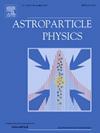Measurement of the re-entrant all-electron spectrum by the High-Energy Particle Detector on board the China Seismo-Electromagnetic Satellite
IF 2.9
3区 物理与天体物理
Q1 ASTRONOMY & ASTROPHYSICS
引用次数: 0
Abstract
Interactions of primary cosmic rays with residual atmospheric nuclei produce secondary leptons through the decay chain of short-lived pions. Even though generated with an upward direction, a fraction of these secondary electrons and positrons is bent back downward towards the Earth by the geomagnetic field lines (hence they are called re-entrant albedo). In this paper, we report on a new measurement of the re-entrant all-electron differential flux in the energy range 10-100 MeV, performed by the High-Energy Particle Detector (HEPD-01) on board the China Seismo-Electromagnetic Satellite (CSES-01) in the near-equatorial region at about 500 km altitude between 2018 and 2022. This analysis focuses on the re-entrant all-electron spectrum that covers the low energy interval in a geographical region characterized by a substantial lack of recent experimental data and can contribute to a more accurate definition of secondary electron and positron population distribution and refine the radiation models in the Earth’s magnetosphere.
中国地震电磁卫星高能粒子探测器对重入全电子谱的测量
初级宇宙射线与残余大气核的相互作用通过短寿命介子的衰变链产生次级轻子。尽管产生的方向是向上的,但这些次级电子和正电子中的一小部分在地磁力线的作用下会向下弯曲回地球(因此它们被称为再入反照率)。本文报道了2018年至2022年间,中国地震电磁卫星(CSES-01)上搭载的高能粒子探测器(HEPD-01)在近赤道地区约500 km高度上对10-100 MeV能量范围内的重入全电子微分通量进行的新测量。该分析侧重于覆盖地理区域低能量区间的再入全电子谱,其特征是大量缺乏最近的实验数据,可以有助于更准确地定义二次电子和正电子种群分布,并改进地球磁层的辐射模型。
本文章由计算机程序翻译,如有差异,请以英文原文为准。
求助全文
约1分钟内获得全文
求助全文
来源期刊

Astroparticle Physics
地学天文-天文与天体物理
CiteScore
8.00
自引率
2.90%
发文量
41
审稿时长
79 days
期刊介绍:
Astroparticle Physics publishes experimental and theoretical research papers in the interacting fields of Cosmic Ray Physics, Astronomy and Astrophysics, Cosmology and Particle Physics focusing on new developments in the following areas: High-energy cosmic-ray physics and astrophysics; Particle cosmology; Particle astrophysics; Related astrophysics: supernova, AGN, cosmic abundances, dark matter etc.; Gravitational waves; High-energy, VHE and UHE gamma-ray astronomy; High- and low-energy neutrino astronomy; Instrumentation and detector developments related to the above-mentioned fields.
 求助内容:
求助内容: 应助结果提醒方式:
应助结果提醒方式:


